PUBH7003 Assignment 1: Qualitative Research Papers Appraisal
VerifiedAdded on 2022/10/11
|15
|2913
|253
Homework Assignment
AI Summary
This assignment critically appraises two qualitative research papers focusing on the lived experiences of obese individuals, their responses to stigma, and the impact of socio-cultural factors. The first paper, by Thomas et al. (2008), explores the lived experiences of people with obesity in Australia using semi-structured interviews, highlighting the diverse experiences and challenges faced by individuals. The second paper, by Malterud and Ulriksen (2011), synthesizes qualitative studies on obesity, stigma, and responsibility in healthcare, revealing how stigma affects healthy coping and effective collaboration. The assignment analyzes the research aims, methodologies, data collection strategies, and findings of both studies, evaluating their strengths and limitations. The analysis includes a discussion on the appropriateness of qualitative research, the approaches used, the organization and presentation of findings, and the interpretation of the data. The assignment also explores the study's argumentation, theoretical perspectives, and the identification and selection of research samples. The assignment concludes by summarizing the major findings of each study and assessing the authors' interpretations of the data.
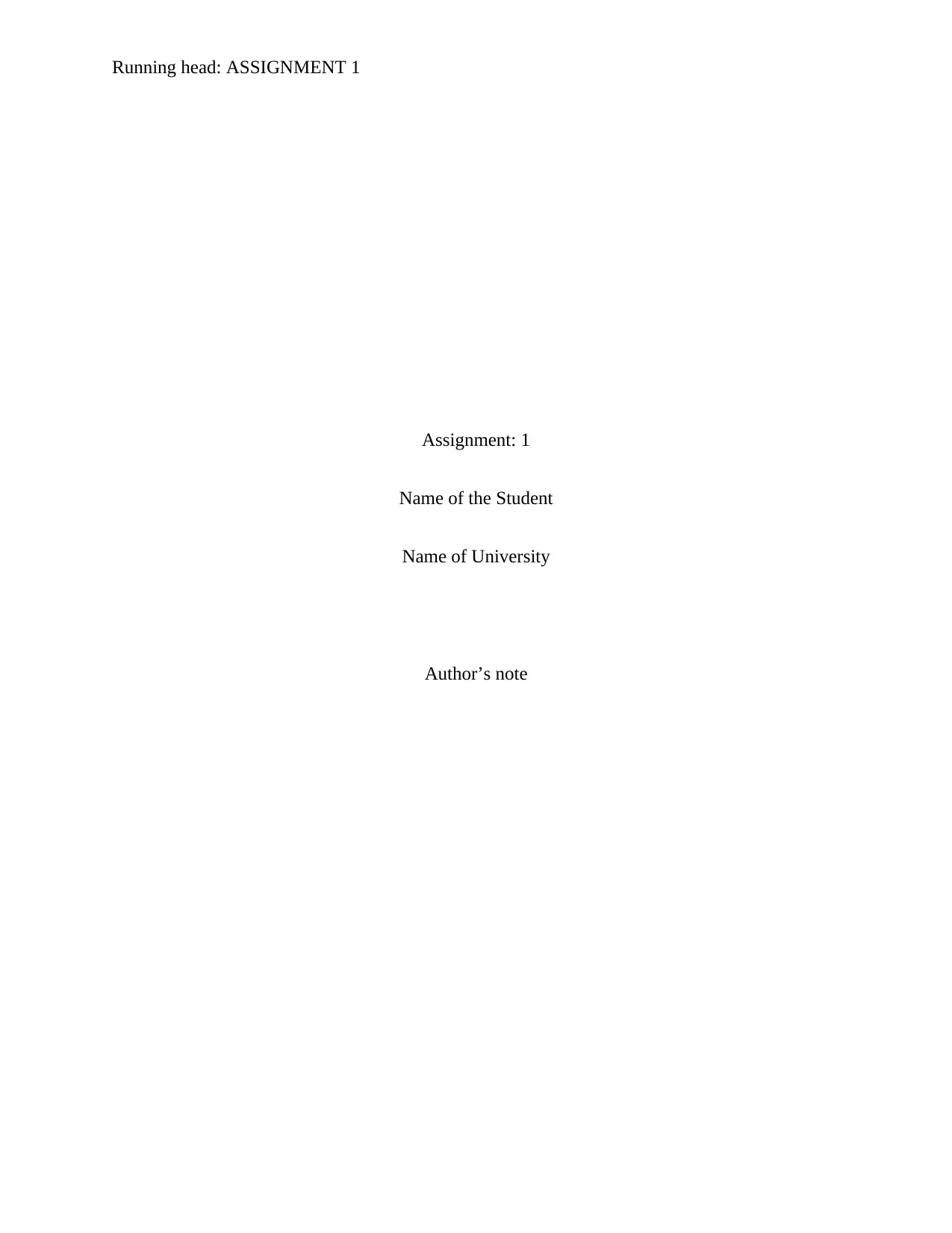
Running head: ASSIGNMENT 1
Assignment: 1
Name of the Student
Name of University
Author’s note
Assignment: 1
Name of the Student
Name of University
Author’s note
Paraphrase This Document
Need a fresh take? Get an instant paraphrase of this document with our AI Paraphraser
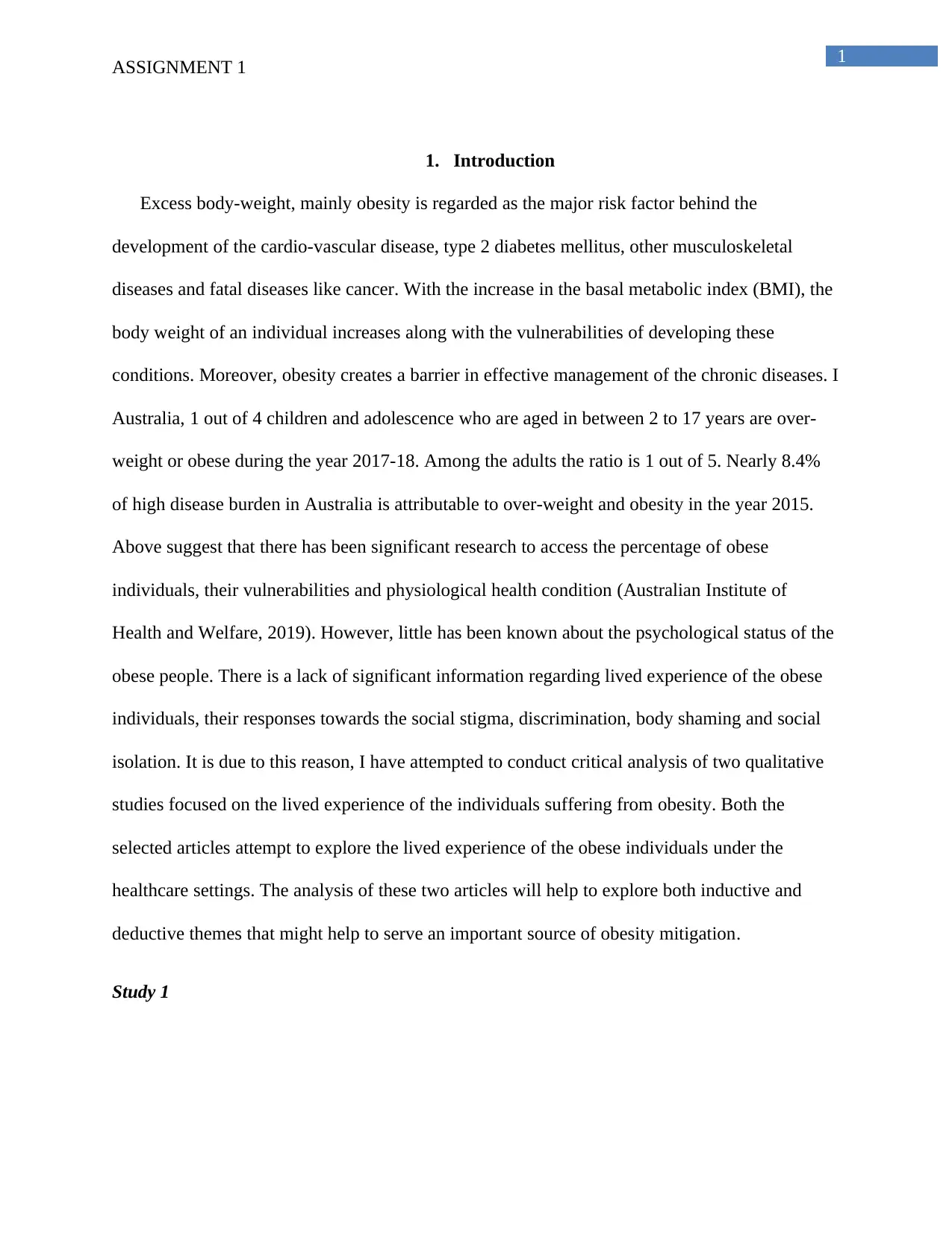
1
ASSIGNMENT 1
1. Introduction
Excess body-weight, mainly obesity is regarded as the major risk factor behind the
development of the cardio-vascular disease, type 2 diabetes mellitus, other musculoskeletal
diseases and fatal diseases like cancer. With the increase in the basal metabolic index (BMI), the
body weight of an individual increases along with the vulnerabilities of developing these
conditions. Moreover, obesity creates a barrier in effective management of the chronic diseases. I
Australia, 1 out of 4 children and adolescence who are aged in between 2 to 17 years are over-
weight or obese during the year 2017-18. Among the adults the ratio is 1 out of 5. Nearly 8.4%
of high disease burden in Australia is attributable to over-weight and obesity in the year 2015.
Above suggest that there has been significant research to access the percentage of obese
individuals, their vulnerabilities and physiological health condition (Australian Institute of
Health and Welfare, 2019). However, little has been known about the psychological status of the
obese people. There is a lack of significant information regarding lived experience of the obese
individuals, their responses towards the social stigma, discrimination, body shaming and social
isolation. It is due to this reason, I have attempted to conduct critical analysis of two qualitative
studies focused on the lived experience of the individuals suffering from obesity. Both the
selected articles attempt to explore the lived experience of the obese individuals under the
healthcare settings. The analysis of these two articles will help to explore both inductive and
deductive themes that might help to serve an important source of obesity mitigation.
Study 1
ASSIGNMENT 1
1. Introduction
Excess body-weight, mainly obesity is regarded as the major risk factor behind the
development of the cardio-vascular disease, type 2 diabetes mellitus, other musculoskeletal
diseases and fatal diseases like cancer. With the increase in the basal metabolic index (BMI), the
body weight of an individual increases along with the vulnerabilities of developing these
conditions. Moreover, obesity creates a barrier in effective management of the chronic diseases. I
Australia, 1 out of 4 children and adolescence who are aged in between 2 to 17 years are over-
weight or obese during the year 2017-18. Among the adults the ratio is 1 out of 5. Nearly 8.4%
of high disease burden in Australia is attributable to over-weight and obesity in the year 2015.
Above suggest that there has been significant research to access the percentage of obese
individuals, their vulnerabilities and physiological health condition (Australian Institute of
Health and Welfare, 2019). However, little has been known about the psychological status of the
obese people. There is a lack of significant information regarding lived experience of the obese
individuals, their responses towards the social stigma, discrimination, body shaming and social
isolation. It is due to this reason, I have attempted to conduct critical analysis of two qualitative
studies focused on the lived experience of the individuals suffering from obesity. Both the
selected articles attempt to explore the lived experience of the obese individuals under the
healthcare settings. The analysis of these two articles will help to explore both inductive and
deductive themes that might help to serve an important source of obesity mitigation.
Study 1
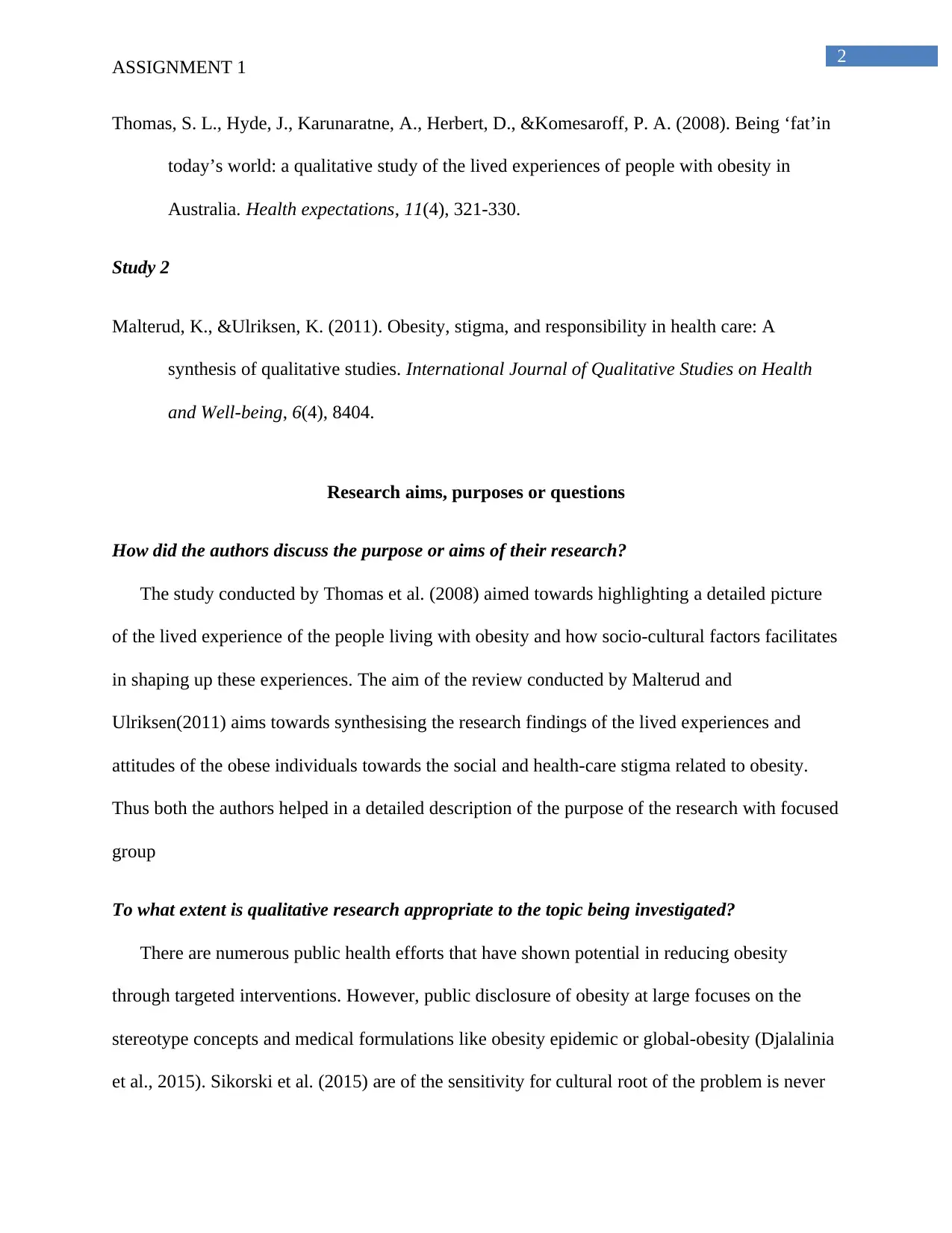
2
ASSIGNMENT 1
Thomas, S. L., Hyde, J., Karunaratne, A., Herbert, D., &Komesaroff, P. A. (2008). Being ‘fat’in
today’s world: a qualitative study of the lived experiences of people with obesity in
Australia. Health expectations, 11(4), 321-330.
Study 2
Malterud, K., &Ulriksen, K. (2011). Obesity, stigma, and responsibility in health care: A
synthesis of qualitative studies. International Journal of Qualitative Studies on Health
and Well-being, 6(4), 8404.
Research aims, purposes or questions
How did the authors discuss the purpose or aims of their research?
The study conducted by Thomas et al. (2008) aimed towards highlighting a detailed picture
of the lived experience of the people living with obesity and how socio-cultural factors facilitates
in shaping up these experiences. The aim of the review conducted by Malterud and
Ulriksen(2011) aims towards synthesising the research findings of the lived experiences and
attitudes of the obese individuals towards the social and health-care stigma related to obesity.
Thus both the authors helped in a detailed description of the purpose of the research with focused
group
To what extent is qualitative research appropriate to the topic being investigated?
There are numerous public health efforts that have shown potential in reducing obesity
through targeted interventions. However, public disclosure of obesity at large focuses on the
stereotype concepts and medical formulations like obesity epidemic or global-obesity (Djalalinia
et al., 2015). Sikorski et al. (2015) are of the sensitivity for cultural root of the problem is never
ASSIGNMENT 1
Thomas, S. L., Hyde, J., Karunaratne, A., Herbert, D., &Komesaroff, P. A. (2008). Being ‘fat’in
today’s world: a qualitative study of the lived experiences of people with obesity in
Australia. Health expectations, 11(4), 321-330.
Study 2
Malterud, K., &Ulriksen, K. (2011). Obesity, stigma, and responsibility in health care: A
synthesis of qualitative studies. International Journal of Qualitative Studies on Health
and Well-being, 6(4), 8404.
Research aims, purposes or questions
How did the authors discuss the purpose or aims of their research?
The study conducted by Thomas et al. (2008) aimed towards highlighting a detailed picture
of the lived experience of the people living with obesity and how socio-cultural factors facilitates
in shaping up these experiences. The aim of the review conducted by Malterud and
Ulriksen(2011) aims towards synthesising the research findings of the lived experiences and
attitudes of the obese individuals towards the social and health-care stigma related to obesity.
Thus both the authors helped in a detailed description of the purpose of the research with focused
group
To what extent is qualitative research appropriate to the topic being investigated?
There are numerous public health efforts that have shown potential in reducing obesity
through targeted interventions. However, public disclosure of obesity at large focuses on the
stereotype concepts and medical formulations like obesity epidemic or global-obesity (Djalalinia
et al., 2015). Sikorski et al. (2015) are of the sensitivity for cultural root of the problem is never
⊘ This is a preview!⊘
Do you want full access?
Subscribe today to unlock all pages.

Trusted by 1+ million students worldwide
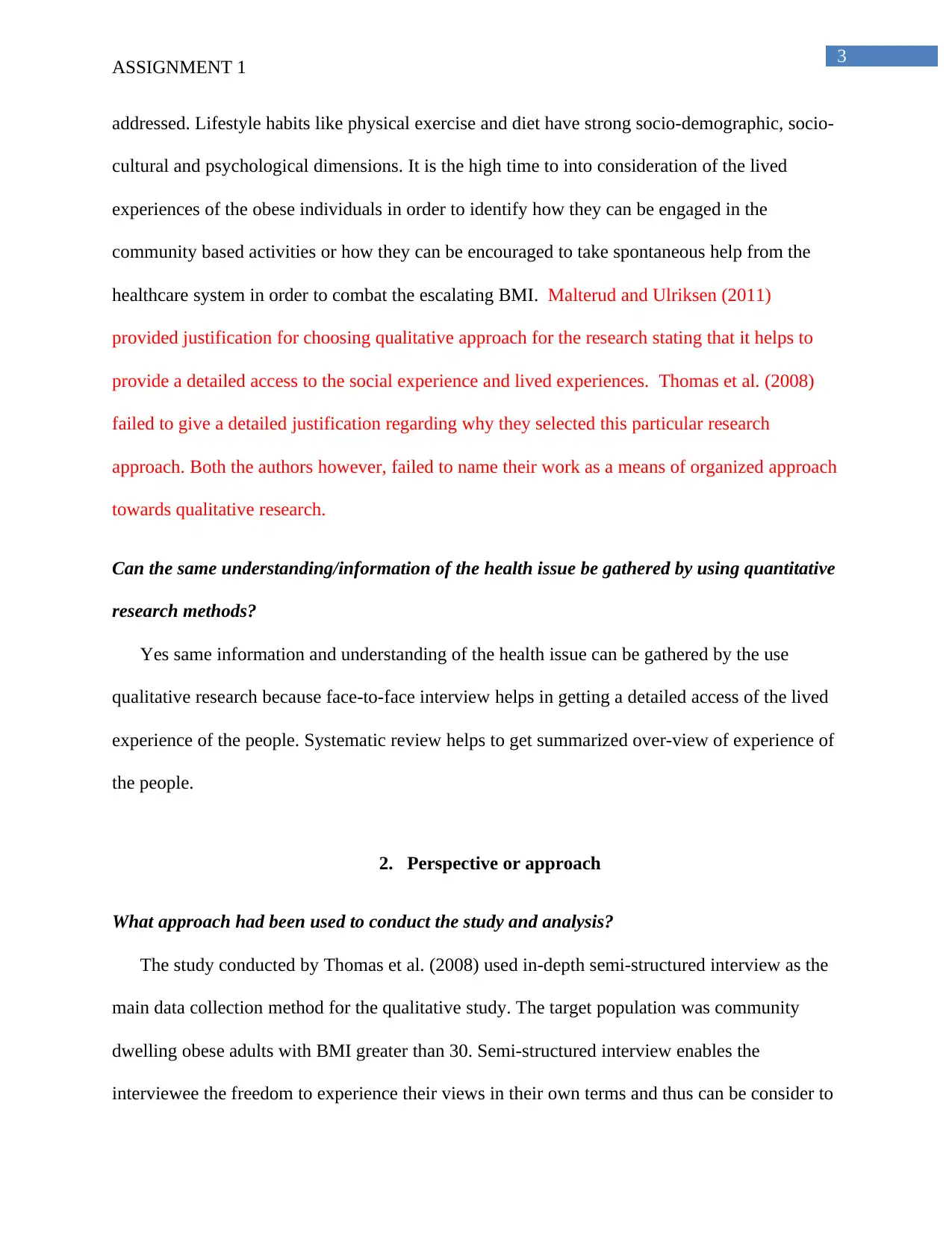
3
ASSIGNMENT 1
addressed. Lifestyle habits like physical exercise and diet have strong socio-demographic, socio-
cultural and psychological dimensions. It is the high time to into consideration of the lived
experiences of the obese individuals in order to identify how they can be engaged in the
community based activities or how they can be encouraged to take spontaneous help from the
healthcare system in order to combat the escalating BMI. Malterud and Ulriksen (2011)
provided justification for choosing qualitative approach for the research stating that it helps to
provide a detailed access to the social experience and lived experiences. Thomas et al. (2008)
failed to give a detailed justification regarding why they selected this particular research
approach. Both the authors however, failed to name their work as a means of organized approach
towards qualitative research.
Can the same understanding/information of the health issue be gathered by using quantitative
research methods?
Yes same information and understanding of the health issue can be gathered by the use
qualitative research because face-to-face interview helps in getting a detailed access of the lived
experience of the people. Systematic review helps to get summarized over-view of experience of
the people.
2. Perspective or approach
What approach had been used to conduct the study and analysis?
The study conducted by Thomas et al. (2008) used in-depth semi-structured interview as the
main data collection method for the qualitative study. The target population was community
dwelling obese adults with BMI greater than 30. Semi-structured interview enables the
interviewee the freedom to experience their views in their own terms and thus can be consider to
ASSIGNMENT 1
addressed. Lifestyle habits like physical exercise and diet have strong socio-demographic, socio-
cultural and psychological dimensions. It is the high time to into consideration of the lived
experiences of the obese individuals in order to identify how they can be engaged in the
community based activities or how they can be encouraged to take spontaneous help from the
healthcare system in order to combat the escalating BMI. Malterud and Ulriksen (2011)
provided justification for choosing qualitative approach for the research stating that it helps to
provide a detailed access to the social experience and lived experiences. Thomas et al. (2008)
failed to give a detailed justification regarding why they selected this particular research
approach. Both the authors however, failed to name their work as a means of organized approach
towards qualitative research.
Can the same understanding/information of the health issue be gathered by using quantitative
research methods?
Yes same information and understanding of the health issue can be gathered by the use
qualitative research because face-to-face interview helps in getting a detailed access of the lived
experience of the people. Systematic review helps to get summarized over-view of experience of
the people.
2. Perspective or approach
What approach had been used to conduct the study and analysis?
The study conducted by Thomas et al. (2008) used in-depth semi-structured interview as the
main data collection method for the qualitative study. The target population was community
dwelling obese adults with BMI greater than 30. Semi-structured interview enables the
interviewee the freedom to experience their views in their own terms and thus can be consider to
Paraphrase This Document
Need a fresh take? Get an instant paraphrase of this document with our AI Paraphraser
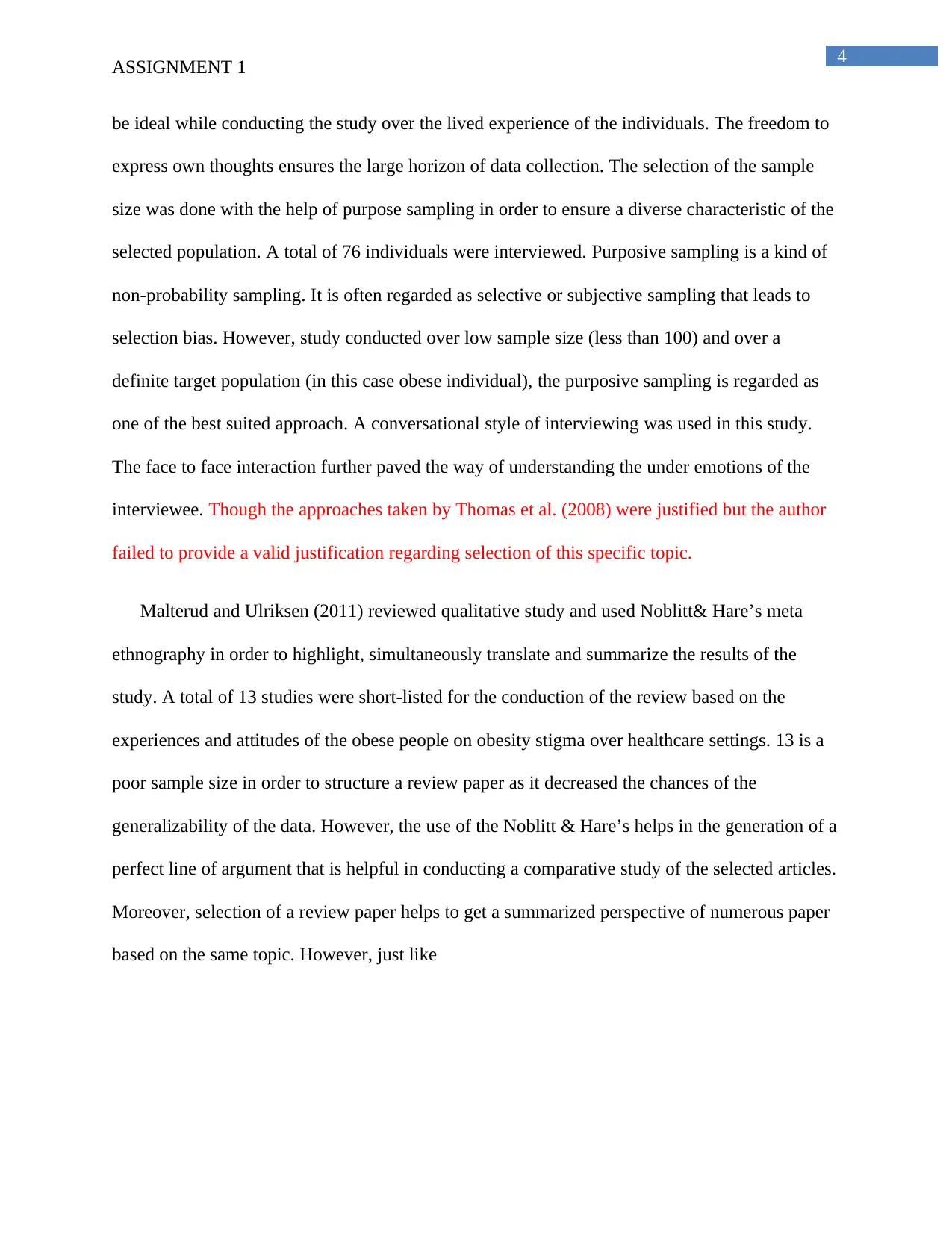
4
ASSIGNMENT 1
be ideal while conducting the study over the lived experience of the individuals. The freedom to
express own thoughts ensures the large horizon of data collection. The selection of the sample
size was done with the help of purpose sampling in order to ensure a diverse characteristic of the
selected population. A total of 76 individuals were interviewed. Purposive sampling is a kind of
non-probability sampling. It is often regarded as selective or subjective sampling that leads to
selection bias. However, study conducted over low sample size (less than 100) and over a
definite target population (in this case obese individual), the purposive sampling is regarded as
one of the best suited approach. A conversational style of interviewing was used in this study.
The face to face interaction further paved the way of understanding the under emotions of the
interviewee. Though the approaches taken by Thomas et al. (2008) were justified but the author
failed to provide a valid justification regarding selection of this specific topic.
Malterud and Ulriksen (2011) reviewed qualitative study and used Noblitt& Hare’s meta
ethnography in order to highlight, simultaneously translate and summarize the results of the
study. A total of 13 studies were short-listed for the conduction of the review based on the
experiences and attitudes of the obese people on obesity stigma over healthcare settings. 13 is a
poor sample size in order to structure a review paper as it decreased the chances of the
generalizability of the data. However, the use of the Noblitt & Hare’s helps in the generation of a
perfect line of argument that is helpful in conducting a comparative study of the selected articles.
Moreover, selection of a review paper helps to get a summarized perspective of numerous paper
based on the same topic. However, just like
ASSIGNMENT 1
be ideal while conducting the study over the lived experience of the individuals. The freedom to
express own thoughts ensures the large horizon of data collection. The selection of the sample
size was done with the help of purpose sampling in order to ensure a diverse characteristic of the
selected population. A total of 76 individuals were interviewed. Purposive sampling is a kind of
non-probability sampling. It is often regarded as selective or subjective sampling that leads to
selection bias. However, study conducted over low sample size (less than 100) and over a
definite target population (in this case obese individual), the purposive sampling is regarded as
one of the best suited approach. A conversational style of interviewing was used in this study.
The face to face interaction further paved the way of understanding the under emotions of the
interviewee. Though the approaches taken by Thomas et al. (2008) were justified but the author
failed to provide a valid justification regarding selection of this specific topic.
Malterud and Ulriksen (2011) reviewed qualitative study and used Noblitt& Hare’s meta
ethnography in order to highlight, simultaneously translate and summarize the results of the
study. A total of 13 studies were short-listed for the conduction of the review based on the
experiences and attitudes of the obese people on obesity stigma over healthcare settings. 13 is a
poor sample size in order to structure a review paper as it decreased the chances of the
generalizability of the data. However, the use of the Noblitt & Hare’s helps in the generation of a
perfect line of argument that is helpful in conducting a comparative study of the selected articles.
Moreover, selection of a review paper helps to get a summarized perspective of numerous paper
based on the same topic. However, just like
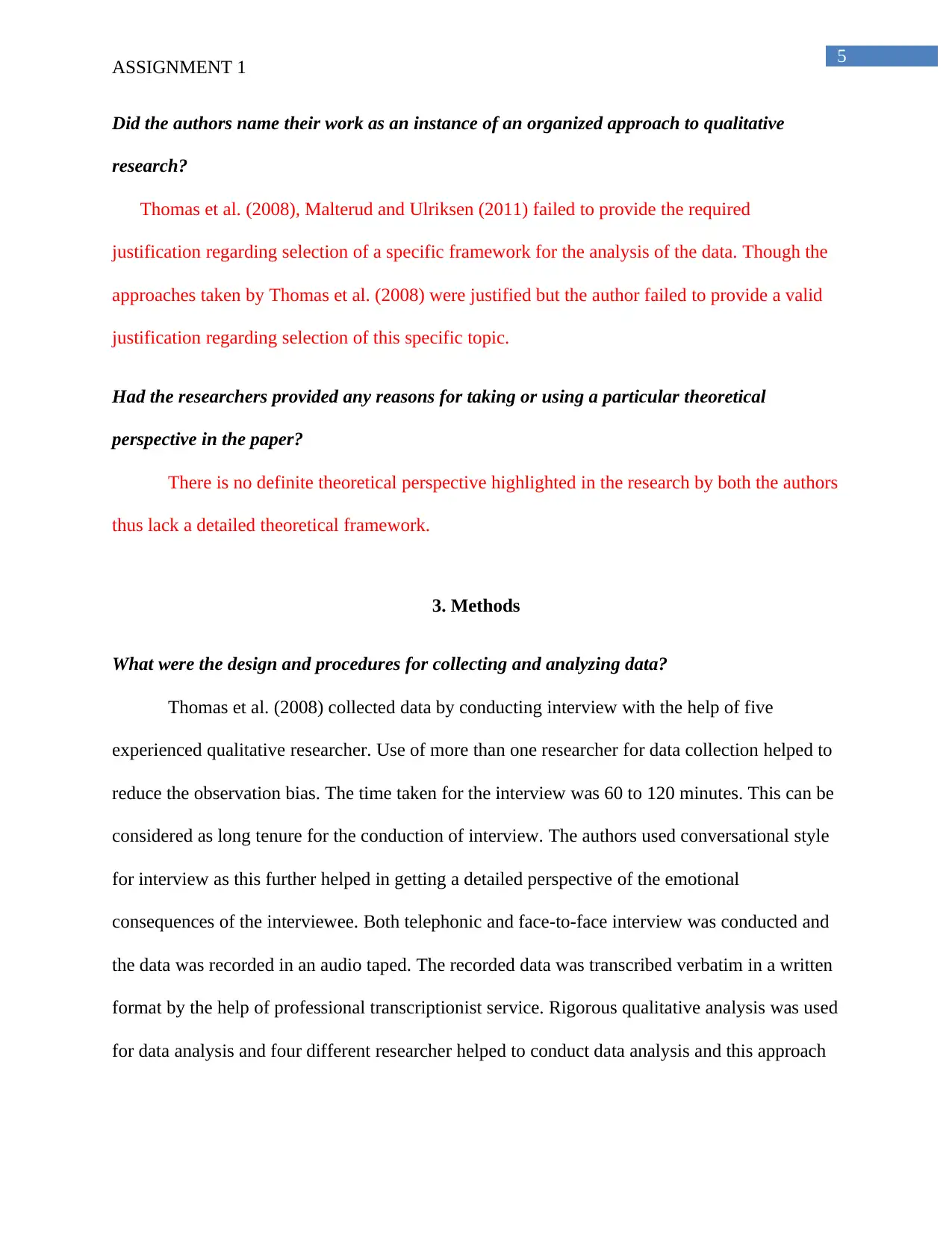
5
ASSIGNMENT 1
Did the authors name their work as an instance of an organized approach to qualitative
research?
Thomas et al. (2008), Malterud and Ulriksen (2011) failed to provide the required
justification regarding selection of a specific framework for the analysis of the data. Though the
approaches taken by Thomas et al. (2008) were justified but the author failed to provide a valid
justification regarding selection of this specific topic.
Had the researchers provided any reasons for taking or using a particular theoretical
perspective in the paper?
There is no definite theoretical perspective highlighted in the research by both the authors
thus lack a detailed theoretical framework.
3. Methods
What were the design and procedures for collecting and analyzing data?
Thomas et al. (2008) collected data by conducting interview with the help of five
experienced qualitative researcher. Use of more than one researcher for data collection helped to
reduce the observation bias. The time taken for the interview was 60 to 120 minutes. This can be
considered as long tenure for the conduction of interview. The authors used conversational style
for interview as this further helped in getting a detailed perspective of the emotional
consequences of the interviewee. Both telephonic and face-to-face interview was conducted and
the data was recorded in an audio taped. The recorded data was transcribed verbatim in a written
format by the help of professional transcriptionist service. Rigorous qualitative analysis was used
for data analysis and four different researcher helped to conduct data analysis and this approach
ASSIGNMENT 1
Did the authors name their work as an instance of an organized approach to qualitative
research?
Thomas et al. (2008), Malterud and Ulriksen (2011) failed to provide the required
justification regarding selection of a specific framework for the analysis of the data. Though the
approaches taken by Thomas et al. (2008) were justified but the author failed to provide a valid
justification regarding selection of this specific topic.
Had the researchers provided any reasons for taking or using a particular theoretical
perspective in the paper?
There is no definite theoretical perspective highlighted in the research by both the authors
thus lack a detailed theoretical framework.
3. Methods
What were the design and procedures for collecting and analyzing data?
Thomas et al. (2008) collected data by conducting interview with the help of five
experienced qualitative researcher. Use of more than one researcher for data collection helped to
reduce the observation bias. The time taken for the interview was 60 to 120 minutes. This can be
considered as long tenure for the conduction of interview. The authors used conversational style
for interview as this further helped in getting a detailed perspective of the emotional
consequences of the interviewee. Both telephonic and face-to-face interview was conducted and
the data was recorded in an audio taped. The recorded data was transcribed verbatim in a written
format by the help of professional transcriptionist service. Rigorous qualitative analysis was used
for data analysis and four different researcher helped to conduct data analysis and this approach
⊘ This is a preview!⊘
Do you want full access?
Subscribe today to unlock all pages.

Trusted by 1+ million students worldwide
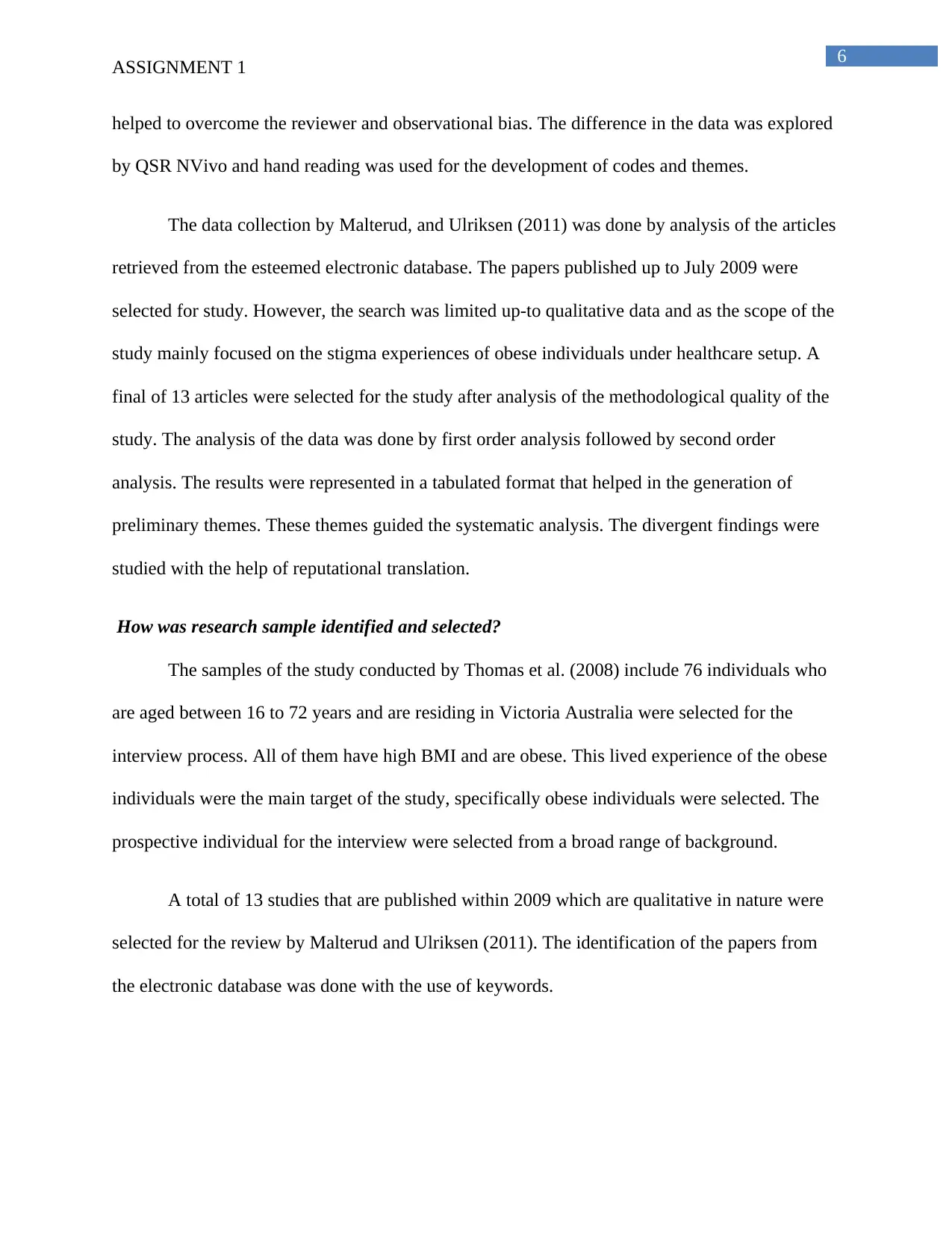
6
ASSIGNMENT 1
helped to overcome the reviewer and observational bias. The difference in the data was explored
by QSR NVivo and hand reading was used for the development of codes and themes.
The data collection by Malterud, and Ulriksen (2011) was done by analysis of the articles
retrieved from the esteemed electronic database. The papers published up to July 2009 were
selected for study. However, the search was limited up-to qualitative data and as the scope of the
study mainly focused on the stigma experiences of obese individuals under healthcare setup. A
final of 13 articles were selected for the study after analysis of the methodological quality of the
study. The analysis of the data was done by first order analysis followed by second order
analysis. The results were represented in a tabulated format that helped in the generation of
preliminary themes. These themes guided the systematic analysis. The divergent findings were
studied with the help of reputational translation.
How was research sample identified and selected?
The samples of the study conducted by Thomas et al. (2008) include 76 individuals who
are aged between 16 to 72 years and are residing in Victoria Australia were selected for the
interview process. All of them have high BMI and are obese. This lived experience of the obese
individuals were the main target of the study, specifically obese individuals were selected. The
prospective individual for the interview were selected from a broad range of background.
A total of 13 studies that are published within 2009 which are qualitative in nature were
selected for the review by Malterud and Ulriksen (2011). The identification of the papers from
the electronic database was done with the use of keywords.
ASSIGNMENT 1
helped to overcome the reviewer and observational bias. The difference in the data was explored
by QSR NVivo and hand reading was used for the development of codes and themes.
The data collection by Malterud, and Ulriksen (2011) was done by analysis of the articles
retrieved from the esteemed electronic database. The papers published up to July 2009 were
selected for study. However, the search was limited up-to qualitative data and as the scope of the
study mainly focused on the stigma experiences of obese individuals under healthcare setup. A
final of 13 articles were selected for the study after analysis of the methodological quality of the
study. The analysis of the data was done by first order analysis followed by second order
analysis. The results were represented in a tabulated format that helped in the generation of
preliminary themes. These themes guided the systematic analysis. The divergent findings were
studied with the help of reputational translation.
How was research sample identified and selected?
The samples of the study conducted by Thomas et al. (2008) include 76 individuals who
are aged between 16 to 72 years and are residing in Victoria Australia were selected for the
interview process. All of them have high BMI and are obese. This lived experience of the obese
individuals were the main target of the study, specifically obese individuals were selected. The
prospective individual for the interview were selected from a broad range of background.
A total of 13 studies that are published within 2009 which are qualitative in nature were
selected for the review by Malterud and Ulriksen (2011). The identification of the papers from
the electronic database was done with the use of keywords.
Paraphrase This Document
Need a fresh take? Get an instant paraphrase of this document with our AI Paraphraser
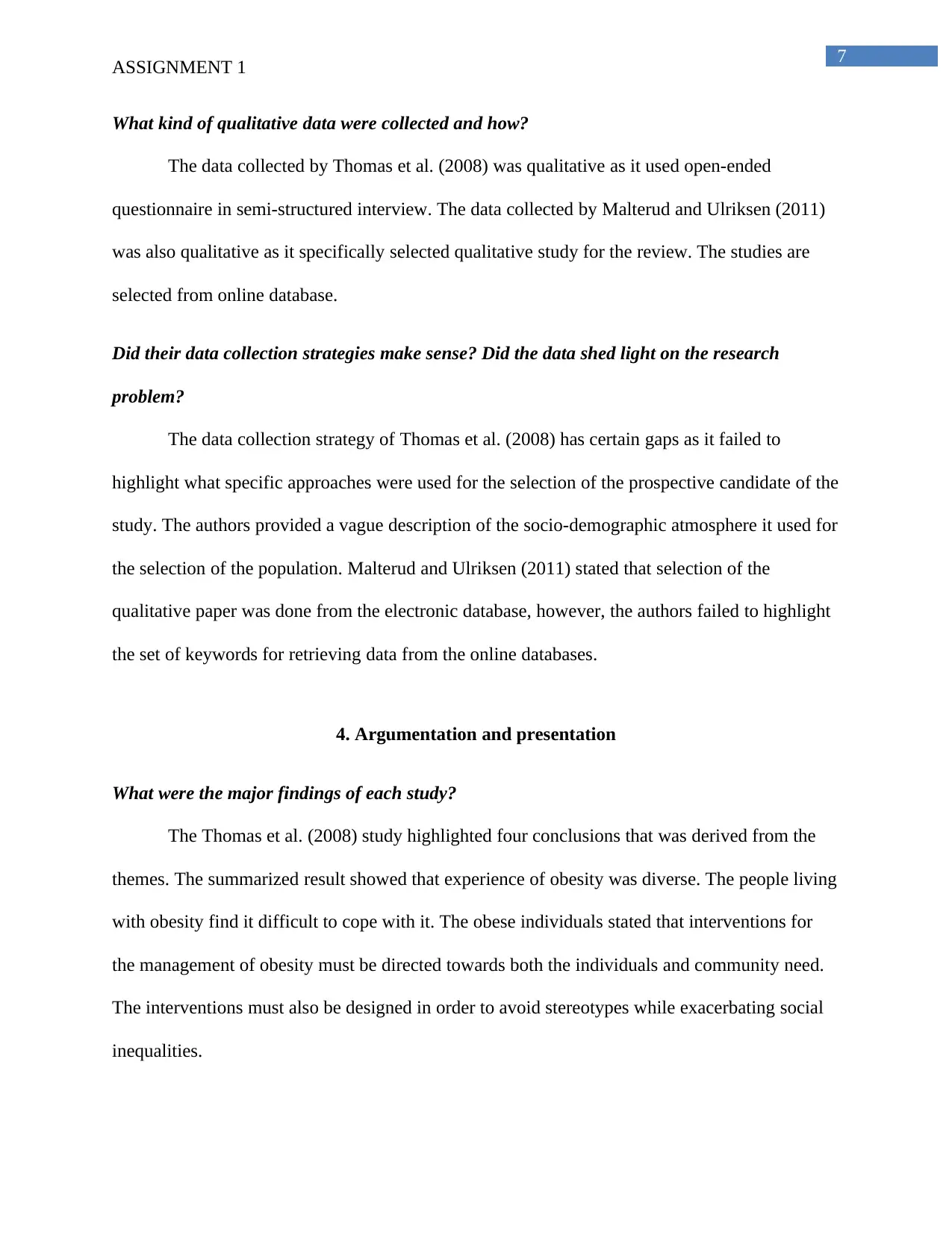
7
ASSIGNMENT 1
What kind of qualitative data were collected and how?
The data collected by Thomas et al. (2008) was qualitative as it used open-ended
questionnaire in semi-structured interview. The data collected by Malterud and Ulriksen (2011)
was also qualitative as it specifically selected qualitative study for the review. The studies are
selected from online database.
Did their data collection strategies make sense? Did the data shed light on the research
problem?
The data collection strategy of Thomas et al. (2008) has certain gaps as it failed to
highlight what specific approaches were used for the selection of the prospective candidate of the
study. The authors provided a vague description of the socio-demographic atmosphere it used for
the selection of the population. Malterud and Ulriksen (2011) stated that selection of the
qualitative paper was done from the electronic database, however, the authors failed to highlight
the set of keywords for retrieving data from the online databases.
4. Argumentation and presentation
What were the major findings of each study?
The Thomas et al. (2008) study highlighted four conclusions that was derived from the
themes. The summarized result showed that experience of obesity was diverse. The people living
with obesity find it difficult to cope with it. The obese individuals stated that interventions for
the management of obesity must be directed towards both the individuals and community need.
The interventions must also be designed in order to avoid stereotypes while exacerbating social
inequalities.
ASSIGNMENT 1
What kind of qualitative data were collected and how?
The data collected by Thomas et al. (2008) was qualitative as it used open-ended
questionnaire in semi-structured interview. The data collected by Malterud and Ulriksen (2011)
was also qualitative as it specifically selected qualitative study for the review. The studies are
selected from online database.
Did their data collection strategies make sense? Did the data shed light on the research
problem?
The data collection strategy of Thomas et al. (2008) has certain gaps as it failed to
highlight what specific approaches were used for the selection of the prospective candidate of the
study. The authors provided a vague description of the socio-demographic atmosphere it used for
the selection of the population. Malterud and Ulriksen (2011) stated that selection of the
qualitative paper was done from the electronic database, however, the authors failed to highlight
the set of keywords for retrieving data from the online databases.
4. Argumentation and presentation
What were the major findings of each study?
The Thomas et al. (2008) study highlighted four conclusions that was derived from the
themes. The summarized result showed that experience of obesity was diverse. The people living
with obesity find it difficult to cope with it. The obese individuals stated that interventions for
the management of obesity must be directed towards both the individuals and community need.
The interventions must also be designed in order to avoid stereotypes while exacerbating social
inequalities.
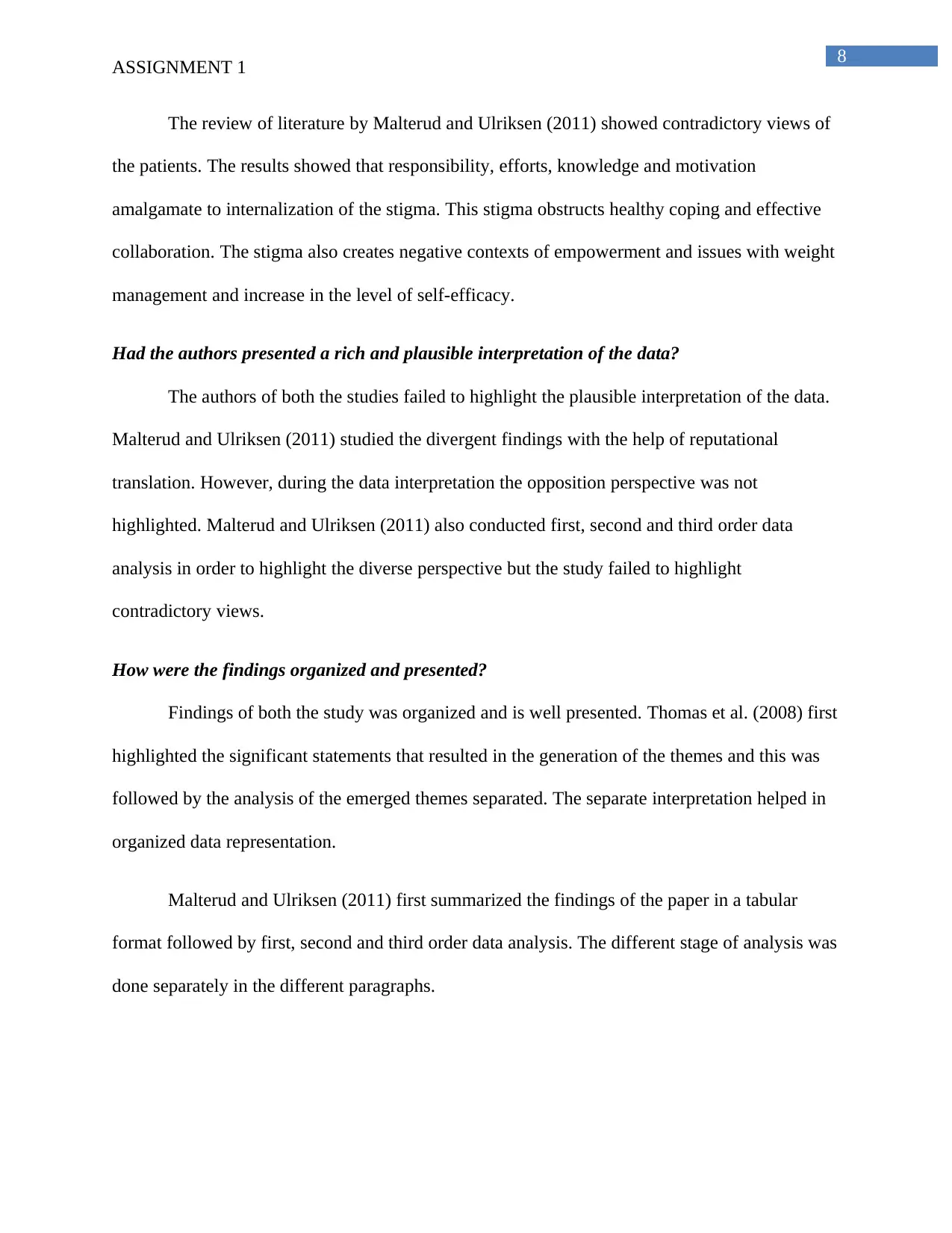
8
ASSIGNMENT 1
The review of literature by Malterud and Ulriksen (2011) showed contradictory views of
the patients. The results showed that responsibility, efforts, knowledge and motivation
amalgamate to internalization of the stigma. This stigma obstructs healthy coping and effective
collaboration. The stigma also creates negative contexts of empowerment and issues with weight
management and increase in the level of self-efficacy.
Had the authors presented a rich and plausible interpretation of the data?
The authors of both the studies failed to highlight the plausible interpretation of the data.
Malterud and Ulriksen (2011) studied the divergent findings with the help of reputational
translation. However, during the data interpretation the opposition perspective was not
highlighted. Malterud and Ulriksen (2011) also conducted first, second and third order data
analysis in order to highlight the diverse perspective but the study failed to highlight
contradictory views.
How were the findings organized and presented?
Findings of both the study was organized and is well presented. Thomas et al. (2008) first
highlighted the significant statements that resulted in the generation of the themes and this was
followed by the analysis of the emerged themes separated. The separate interpretation helped in
organized data representation.
Malterud and Ulriksen (2011) first summarized the findings of the paper in a tabular
format followed by first, second and third order data analysis. The different stage of analysis was
done separately in the different paragraphs.
ASSIGNMENT 1
The review of literature by Malterud and Ulriksen (2011) showed contradictory views of
the patients. The results showed that responsibility, efforts, knowledge and motivation
amalgamate to internalization of the stigma. This stigma obstructs healthy coping and effective
collaboration. The stigma also creates negative contexts of empowerment and issues with weight
management and increase in the level of self-efficacy.
Had the authors presented a rich and plausible interpretation of the data?
The authors of both the studies failed to highlight the plausible interpretation of the data.
Malterud and Ulriksen (2011) studied the divergent findings with the help of reputational
translation. However, during the data interpretation the opposition perspective was not
highlighted. Malterud and Ulriksen (2011) also conducted first, second and third order data
analysis in order to highlight the diverse perspective but the study failed to highlight
contradictory views.
How were the findings organized and presented?
Findings of both the study was organized and is well presented. Thomas et al. (2008) first
highlighted the significant statements that resulted in the generation of the themes and this was
followed by the analysis of the emerged themes separated. The separate interpretation helped in
organized data representation.
Malterud and Ulriksen (2011) first summarized the findings of the paper in a tabular
format followed by first, second and third order data analysis. The different stage of analysis was
done separately in the different paragraphs.
⊘ This is a preview!⊘
Do you want full access?
Subscribe today to unlock all pages.

Trusted by 1+ million students worldwide
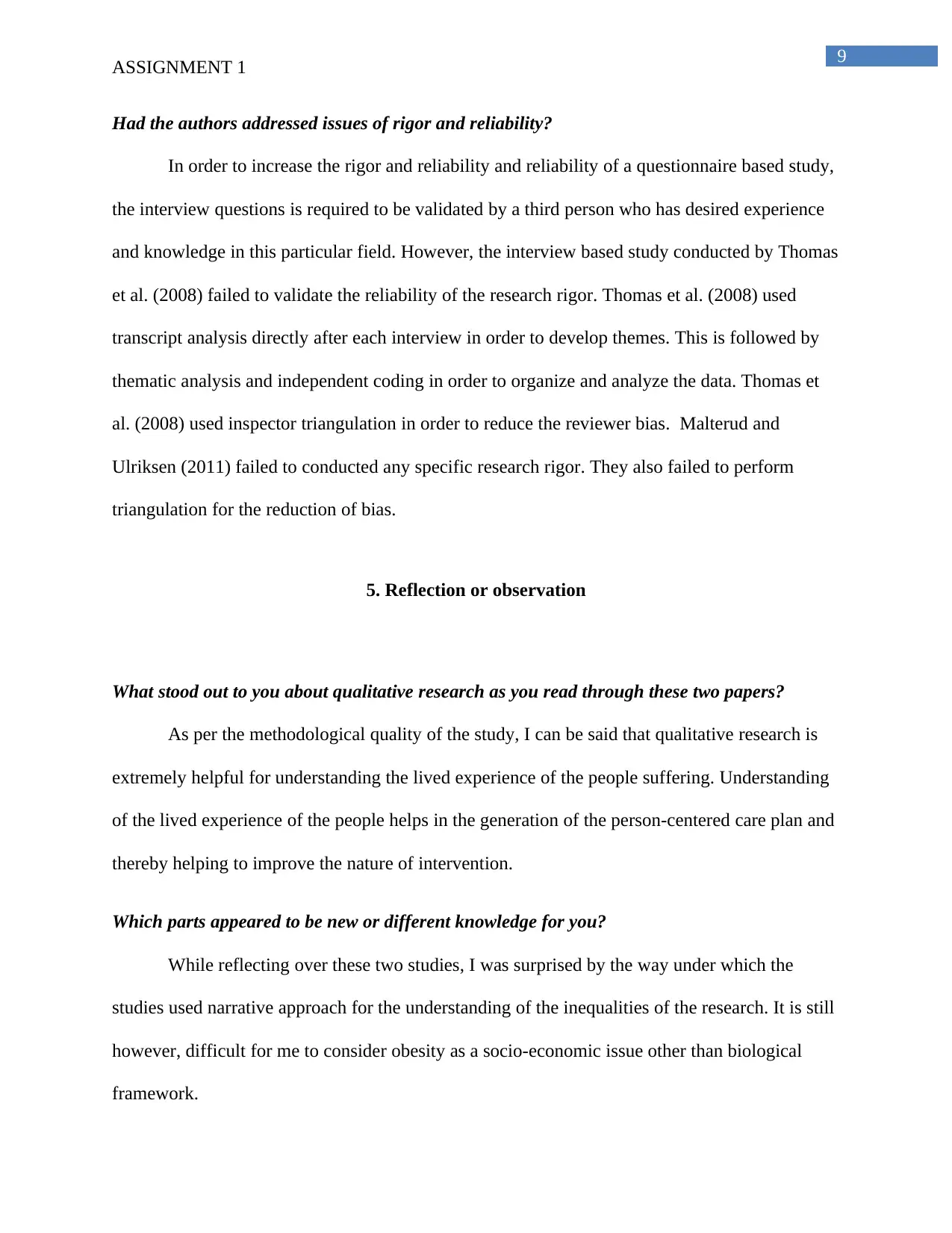
9
ASSIGNMENT 1
Had the authors addressed issues of rigor and reliability?
In order to increase the rigor and reliability and reliability of a questionnaire based study,
the interview questions is required to be validated by a third person who has desired experience
and knowledge in this particular field. However, the interview based study conducted by Thomas
et al. (2008) failed to validate the reliability of the research rigor. Thomas et al. (2008) used
transcript analysis directly after each interview in order to develop themes. This is followed by
thematic analysis and independent coding in order to organize and analyze the data. Thomas et
al. (2008) used inspector triangulation in order to reduce the reviewer bias. Malterud and
Ulriksen (2011) failed to conducted any specific research rigor. They also failed to perform
triangulation for the reduction of bias.
5. Reflection or observation
What stood out to you about qualitative research as you read through these two papers?
As per the methodological quality of the study, I can be said that qualitative research is
extremely helpful for understanding the lived experience of the people suffering. Understanding
of the lived experience of the people helps in the generation of the person-centered care plan and
thereby helping to improve the nature of intervention.
Which parts appeared to be new or different knowledge for you?
While reflecting over these two studies, I was surprised by the way under which the
studies used narrative approach for the understanding of the inequalities of the research. It is still
however, difficult for me to consider obesity as a socio-economic issue other than biological
framework.
ASSIGNMENT 1
Had the authors addressed issues of rigor and reliability?
In order to increase the rigor and reliability and reliability of a questionnaire based study,
the interview questions is required to be validated by a third person who has desired experience
and knowledge in this particular field. However, the interview based study conducted by Thomas
et al. (2008) failed to validate the reliability of the research rigor. Thomas et al. (2008) used
transcript analysis directly after each interview in order to develop themes. This is followed by
thematic analysis and independent coding in order to organize and analyze the data. Thomas et
al. (2008) used inspector triangulation in order to reduce the reviewer bias. Malterud and
Ulriksen (2011) failed to conducted any specific research rigor. They also failed to perform
triangulation for the reduction of bias.
5. Reflection or observation
What stood out to you about qualitative research as you read through these two papers?
As per the methodological quality of the study, I can be said that qualitative research is
extremely helpful for understanding the lived experience of the people suffering. Understanding
of the lived experience of the people helps in the generation of the person-centered care plan and
thereby helping to improve the nature of intervention.
Which parts appeared to be new or different knowledge for you?
While reflecting over these two studies, I was surprised by the way under which the
studies used narrative approach for the understanding of the inequalities of the research. It is still
however, difficult for me to consider obesity as a socio-economic issue other than biological
framework.
Paraphrase This Document
Need a fresh take? Get an instant paraphrase of this document with our AI Paraphraser
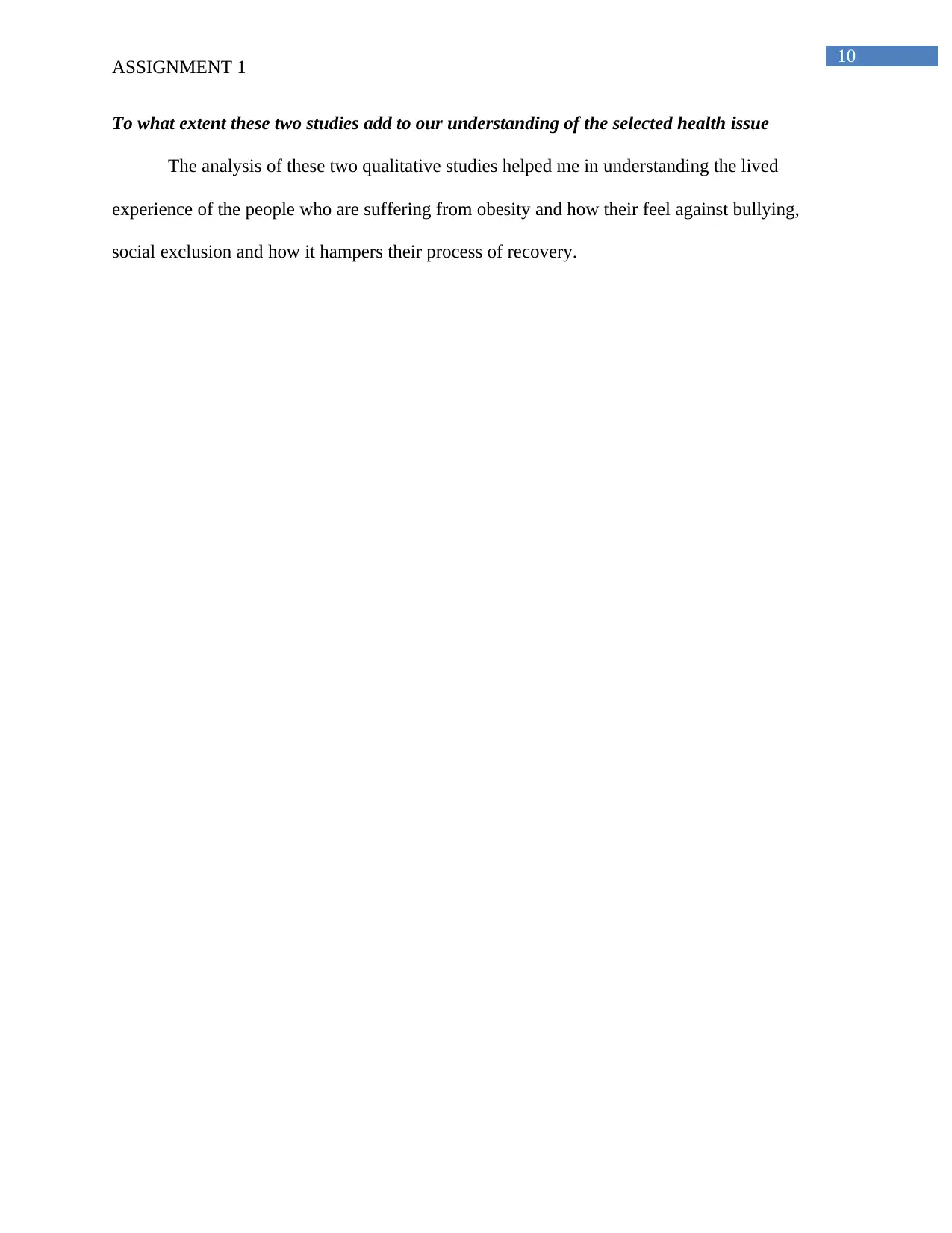
10
ASSIGNMENT 1
To what extent these two studies add to our understanding of the selected health issue
The analysis of these two qualitative studies helped me in understanding the lived
experience of the people who are suffering from obesity and how their feel against bullying,
social exclusion and how it hampers their process of recovery.
ASSIGNMENT 1
To what extent these two studies add to our understanding of the selected health issue
The analysis of these two qualitative studies helped me in understanding the lived
experience of the people who are suffering from obesity and how their feel against bullying,
social exclusion and how it hampers their process of recovery.
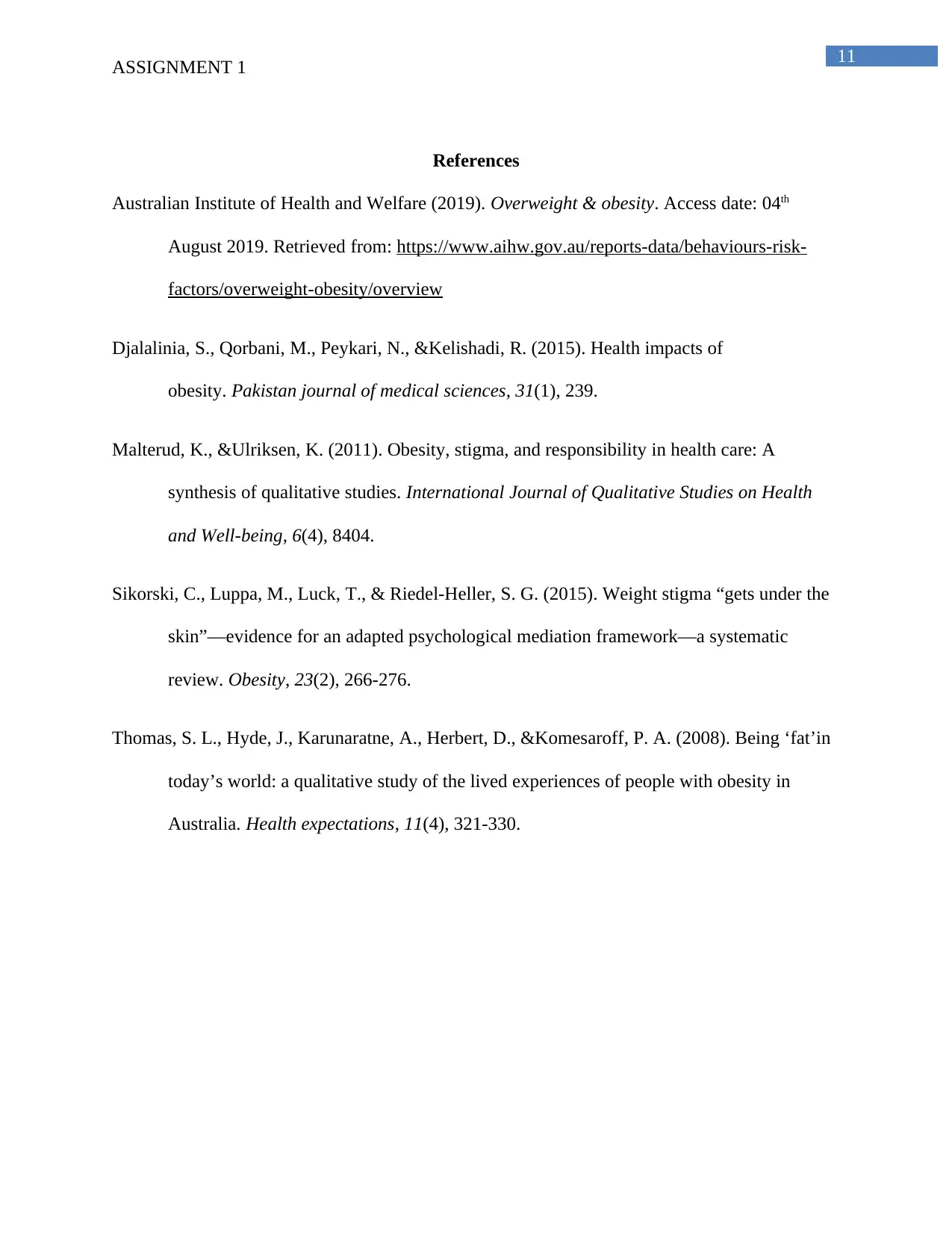
11
ASSIGNMENT 1
References
Australian Institute of Health and Welfare (2019). Overweight & obesity. Access date: 04th
August 2019. Retrieved from: https://www.aihw.gov.au/reports-data/behaviours-risk-
factors/overweight-obesity/overview
Djalalinia, S., Qorbani, M., Peykari, N., &Kelishadi, R. (2015). Health impacts of
obesity. Pakistan journal of medical sciences, 31(1), 239.
Malterud, K., &Ulriksen, K. (2011). Obesity, stigma, and responsibility in health care: A
synthesis of qualitative studies. International Journal of Qualitative Studies on Health
and Well-being, 6(4), 8404.
Sikorski, C., Luppa, M., Luck, T., & Riedel‐Heller, S. G. (2015). Weight stigma “gets under the
skin”—evidence for an adapted psychological mediation framework—a systematic
review. Obesity, 23(2), 266-276.
Thomas, S. L., Hyde, J., Karunaratne, A., Herbert, D., &Komesaroff, P. A. (2008). Being ‘fat’in
today’s world: a qualitative study of the lived experiences of people with obesity in
Australia. Health expectations, 11(4), 321-330.
ASSIGNMENT 1
References
Australian Institute of Health and Welfare (2019). Overweight & obesity. Access date: 04th
August 2019. Retrieved from: https://www.aihw.gov.au/reports-data/behaviours-risk-
factors/overweight-obesity/overview
Djalalinia, S., Qorbani, M., Peykari, N., &Kelishadi, R. (2015). Health impacts of
obesity. Pakistan journal of medical sciences, 31(1), 239.
Malterud, K., &Ulriksen, K. (2011). Obesity, stigma, and responsibility in health care: A
synthesis of qualitative studies. International Journal of Qualitative Studies on Health
and Well-being, 6(4), 8404.
Sikorski, C., Luppa, M., Luck, T., & Riedel‐Heller, S. G. (2015). Weight stigma “gets under the
skin”—evidence for an adapted psychological mediation framework—a systematic
review. Obesity, 23(2), 266-276.
Thomas, S. L., Hyde, J., Karunaratne, A., Herbert, D., &Komesaroff, P. A. (2008). Being ‘fat’in
today’s world: a qualitative study of the lived experiences of people with obesity in
Australia. Health expectations, 11(4), 321-330.
⊘ This is a preview!⊘
Do you want full access?
Subscribe today to unlock all pages.

Trusted by 1+ million students worldwide
1 out of 15
Related Documents
Your All-in-One AI-Powered Toolkit for Academic Success.
+13062052269
info@desklib.com
Available 24*7 on WhatsApp / Email
![[object Object]](/_next/static/media/star-bottom.7253800d.svg)
Unlock your academic potential
Copyright © 2020–2025 A2Z Services. All Rights Reserved. Developed and managed by ZUCOL.





